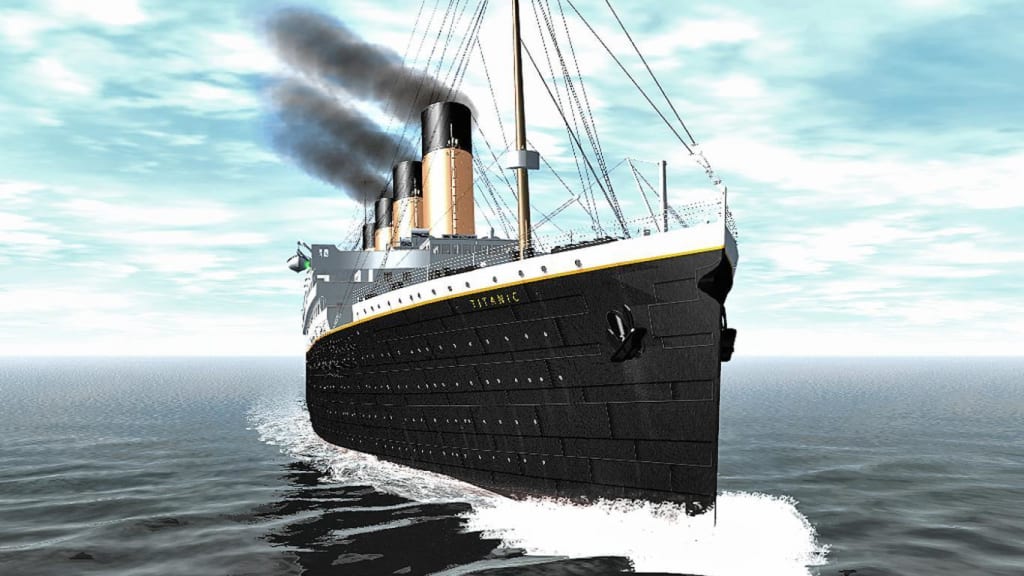
“Suddenly there was a wild coming together of voices from the ship and we noticed an unusual commotion among the people about the railing,” she said. “Then the awful thing happened, the thing that will remain in my memory until the day I die.”
Dorothy listened as 1,500 people cried out to be saved, a noise she described as a horrific mixture of yells, shrieks and moans. This was counterpointed by a deeper sound emanating from under the water, the noise of explosions that she likened to the terrific power of Niagara Falls. “No one can describe the frightful sounds,” she remembered later.
Before stepping onto the Titanic, Dorothy Gibson had already transformed herself from an ordinary New Jersey girl into a model for the famous illustrator Harrison Fisher—whose lush images of idealized American beauty graced the covers of popular magazines—and then into a star of the silent screen.
By the spring of 1912, Dorothy was feeling so overworked that she pleaded with her employers at the Éclair studios in Fort Lee, New Jersey, to grant her a holiday. The days were long, and she realized that, in effect, there was “very little of the glamour connected with movie stars.” She may have been earning $175 a week—the equivalent of nearly $4,000 today—but she was exhausted; she even went so far as to consider quitting the studio. “I was feeling very run down and everyone insisted I go away for a while,” she recalled later. “So Mr. Brulatour made arrangements for me to have a wondrous holiday abroad. It seemed the ideal solution.” (Her married 42-year-old lover, Éclair’s Jules Brulatour, was one of the most powerful producers in the film industry.)
Dorothy and her mother sailed for Europe on March 17, 1912, with an itinerary that was to include not only the capitals of the Continent, but also Algiers and Egypt. However, when they arrived in Genoa from Venice on April 8, they received a telegram at their hotel requesting that Dorothy return to America. An emergency had arisen at the studio; she was needed to start work at once on a series of films. Although she had been away for only three weeks, she had benefited from the change of scene—she said she felt “like a new woman”—and cabled back to tell the studio of her plans. After a brief stopover in Paris, she would sail back to New York from Cherbourg on April 10.
There was silence in the lifeboat. “No one said a word,” recalled Dorothy. “There was nothing to say and nothing we could do.” Faced with the bitter cold and increasingly choppy seas, Dorothy had to acknowledge the possibility that she might not last the night. Had the wireless operators managed to send out a distress signal and call for the help of any nearby ships? The possibility that they could drift for miles in the middle of the harsh Atlantic for days on end was suddenly very real.
As dawn broke on April 15, the passengers in Lifeboat 7 saw a row of lights and a dark cloud of smoke in the distance.“Warming ourselves as best we could in the cramped quarters of the lifeboat, we watched that streak of black smoke grow larger and larger,” recalled Dorothy. “And then we were able to discern the hull of a steamship heading in our direction.”
The men on the lifeboat, now with hands numbed by cold, rowed with extra vigor toward the Carpathia, which had picked up Titanic’s distress signals and had traveled 58 miles in an effort to rescue its survivors. As the sun cast its weak early-morning light across the sea, Dorothy noticed a few green cushions floating in the ocean; she recognized them as being from the sofas on the Titanic. The morning light—which soon became bright and fierce—also revealed the numerous icebergs that crowded around them.
At around 6 o’clock the lifeboat carrying Dorothy Gibson drew up alongside the Carpathia. A few moments later, after she had climbed the rope ladder that had been lowered down from above, she found herself on deck. Still wearing her damp, wind-swept evening gown, Dorothy was approached by Carpathia passengers James Russell Lowell and his wife, and asked whether she would like to share their cabin. After eating breakfast, she retired to their quarters, where she slept for the next 26 hours.
Jules Brulatour had always intended to send a film crew to the pier to record Dorothy’s arrival in New York; he was one of the first to realize that the newsreel could be used as a powerful publicity tool and that the star’s return to America on board the world’s most famous rescue ship would help boost box-office numbers. But suddenly he found himself with an extraordinary story on his hands. Information about the loss of the Titanic was in short supply—initially some newspapers had claimed that all its passengers had survived. Capt. Arthur Rostron of the Carpathia had placed a blanket ban on information from the vessel being leaked to the news media—the wireless service could be used, he said, only for communication with the authorities and for relay of messages between survivors and their families, as well as the task of providing a list of which of the Titanic’s passengers had perished.
As the Carpathia sailed into New York—on the stormy night of Thursday, April 18—it was surrounded by a mass of tiny vessels, all chartered by news corporations desperate to break what would be one of the biggest stories of modern times. From their tugs, reporters shouted through megaphones offering terrific sums of money for information and exclusives, but Captain Rostron said he would shoot any pressmen who dared venture aboard his ship.
However, one of his original passengers, Carlos F. Hurd, was a veteran journalist for the St. Louis Post-Dispatch, and over the course of the past four days he had spoken to many survivors, amassing enough information for a 5,000-word story. Hurd’s only problem was how to get the report off the ship. He managed to send a wireless message to a friend at the New York Evening World, which, in turn, chartered a tug to sail to the Carpathia. Out of sight of the captain, Hurd stuffed his manuscript into an oilskin bag, which he then threw down to the waiting boat. The final edition of the New York Evening World, published on April 18, carried a digest of Hurd’s report, which was published in full the next morning. The story—“Titanic Boilers Blew up, Breaking Her in Two After Striking Berg”—began: “Fifteen hundred lives—the figures will hardly vary in either direction by more than a few dozen—were lost in the sinking of the Titanic, which struck an iceberg at 11:45 p.m., Sunday, and was at the ocean’s bottom two hours and thirty-five minutes after.”
As Dorothy Gibson stood on the deck of the Carpathia, the night was so black that she could hardly make out the skyline of New York. Unknown to her, thousands of people had come out that rainy night to witness the arrival of the Carpathia. Dorothy “ran crying down the ramp” into the arms of her stepfather, soon followed by her mother. Leonard Gibson ushered his stepdaughter and wife through the crowd and into a taxi and whisked them off to a New York restaurant. But there was only one thing on Dorothy’s mind—her lover, Brulatour. She realized that it would have been inappropriate for him to meet her at the pier—this would have given rise to scandal—but she desperately needed to see him. After a couple of hours, she drove to the hotel where she had arranged to meet him.
That night Brulatour presented her with an engagement ring—a cluster of diamonds worth $1,000—and a plan: to make a dramatic one-reel film of her survival. Soon, he said, she would not only be his wife, but she would be more famous than ever before. The loss of the Titanic would make both things possible.
The public’s appetite for information and details—accounts of suffering, bravery, self-sacrifice and selfishness—seemed insatiable, and Brulatour at first took advantage of it by employing the relatively new medium of newsreel. His footage of the docking of the Carpathia—which was spliced together with scenes of Capt. Edward J. Smith, who had been lost in the disaster, walking on the bridge of the Titanic’s sister ship, the Olympic, and shots of icebergs from the area where the liner sank, together with images of the launching of the liner—premiered in East Coast theaters on April 22. Not only was Brulatour’s Animated Weekly newsreel “the first on the scene with specially chartered tugboats and an extra relay of cameramen,” according to Billboard magazine, but it also showed that “the motion picture may fairly equal the press in bringing out a timely subject and one of startling interest to the public at large.”
Brulatour hyped the newsreel as “the most famous film in the whole world,” and so it proved, packing theaters across America over the following weeks. The pioneering movie mogul organized a private screening for Guglielmo Marconi—the inventor of the wireless technology that had played a central part in the Titanic story—and gave a copy of the film to President William Howard Taft, whose close friend Maj. Archie Butt had died in the sinking. Spurred on by the success of his Animated Weekly feature, Brulatour decided to go ahead with a silent film based on the disaster, starring his lover, authentic Titanic survivor Dorothy Gibson.
Within a few days of her arrival in New York, Dorothy had sketched out a rough outline for a story. She would play Miss Dorothy, a young woman traveling in Europe who is due to return to America on the Titanic to marry her sweetheart, Ensign Jack, in service with the U.S. Navy.
Shooting began almost immediately at the Fort Lee studio and on location on board a derelict freighter that lay in New York Harbor. She was clad in the same outfit she had worn the night she had escaped the sinking ship—a white silk evening dress, a sweater, an overcoat and black pumps.The verisimilitude of the experience was overwhelming. This wasn’t so much acting, in its conventional form at least, as replaying. Dorothy drew on her memory and shaped it into a reconstruction.
When the film was released, on May 16, 1912, just a month after the sinking, it was celebrated for its technical realism and emotional power. “The startling story of the world’s greatest sea disaster is the sensation of the country,” stated the Moving Picture News. “Miss Dorothy Gibson, a heroine of the shipwreck and one of the most talked-of survivors, tells in this motion picture masterpiece of the enthralling tragedy among the icebergs.” (The actual film no longer survives.)
“The nation and the world had been profoundly grieved by the sinking of the Titanic,” she said, “and I had the opportunity to pay tribute to those who gave their lives on that awful night. That is all I tried to do.” In truth, the experience had left her feeling hollow, disassociated from her reality. Soon after the release of Saved from the Titanic, Dorothy walked out of her dressing room at the Fort Lee studios and turned her back on the movie business. She was, she stated, “dissatisfied.”
At some point during the summer or autumn of 1912—just as Brulatour was forming, with Carl Laemmle, the Universal Film Manufacturing Company, later to become Universal Pictures—Brulatour’s wife, Clara, finally decided to bring the farce that was her marriage to an end. After scandalous and protracted divorce proceedings, Gibson married Brulatour on July 6, 1917, in New York. It soon became obvious that whatever spark they had between them had been kept alive by the illicit nature of the relationship. The couple divorced in 1923.
Dorothy fled to Europe, where her mother had already settled. Ensconced in Paris, she had enough money from her alimony for everyday luxuries such as cocktails and champagne and entertained a wide range of bohemian friends including the writers Colette, H.G. Wells and James Joyce. “Oh my, what a time I am having!” she told a journalist in 1934. “I never cared much for motion pictures, you see, and I am too glad to be free of that work. I tell you it was an immense burden. I have had my share of troubles, as you know, but since coming to France, I have recovered from that and feel happy at last. Who could not be deliriously happy in this country? I have such fun. But I fear it cannot go on like this always. I have had my dream life, and am sure that someday a dark cloud will come and wash it all away!”
The shadow she feared would destroy her dream life was World War II. In May 1940, Dorothy was in Florence to collect her mother and bring her back to France when Germany invaded Holland and Belgium. It would still have been possible for the two women to return to America. The reason they didn’t? Certainly their experience on the Titanic was a factor. “I must say I never wanted to make the Ocean trip to America at this time,” said Dorothy later in an affidavit, “as my mother and I were most timid on the ocean—we had been in a shipwreck—but I also never wanted to stay in Italy, but we just waited in Italy always hoping things would be better to travel.”





Comments
There are no comments for this story
Be the first to respond and start the conversation.